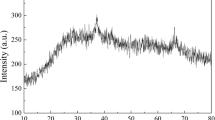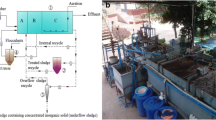Abstract
An advanced sludge reduction process, i. e. sludge reduction and phosphorous removal process, was developed. The results show that excellent sludge reduction and biological phosphorous removal can be achieved perfectly in this system. When chemical oxygen demand ρ (COD) is 332 – 420 mg/L, concentration of ammonia ρ(NH3-N) is 30 – 40 mg/L and concentration of total phosphorous ρ(TP) is 6.0 – 9.0 mg/L in influent, the system still ensures ρ(COD)<23 mg/L, ρ(NH3-N)<3.2 mg/L and ρ(TP)<0.72 mg/L in effluent. Besides, when the concentration of dissolved oxygen ρ(DO) is around 1.0 mg/L, sludge production is less than 0.140 g with the consumption of 1 g COD, and the phosphorous removal exceeds 91%. Also, 48.4% of total nitrogen is removed by simultaneous nitrification and denitrification.
Similar content being viewed by others
References
Wei Y S, van Houten R T, Borger A R, et al. Minimization of excess sludge production for biological wastewater treatment[J]. Water Research, 2003, 37(18): 4453–4467.
Low E W, Chase H A. Reducing production of excess biomass during wastewater treatment[J]. Water Research, 1999, 33(5): 1119–1132.
Saby S, Djafer M, Chen G H. Effect of low ORP in anoxic sludge zone on excess sludge production in oxic-settling-anoxic activated sludge process[J]. Water Research, 2003, 37(1): 11–20.
Ahn K H, Park K Y, Maeng S K, et al. Ozonation of wastewater sludge for reduction and recycling[J]. Water Science and Technology, 2002, 46(10): 71–77.
JI Fang-ying, LUO Gu-yuan. ERP-SBR bio-chemical process for nitrogen and phosphorus removal by draining out anaerobic rich phosphate supernatant [J]. Technology of Water Treatment, 2005, 31(1): 57–61. (in Chinese)
JI Fang-ying, LUO Gu-yuan, YANG Qin, et al. Biological phosphorous removal capability in SBR system using exernal recycle of activated sludge [J]. China Water and Wastewater, 2002, 18(5): 1–5. (in Chinese)
Edit Committee of State Environmental Protection Administration of China. Test and analysis methods of water and wastewater[M]. 4th ed. Beijing: China Enviromental Science Press, 2002. (in Chinese)
Fukase T, Shibata M, Miyaji Y. Role of an anaerobic stage on biological phosphorus removal[J]. Water Science and Technology, 1985, 17(1): 69–80.
Janssen P M J, Rulkens W H, Rensink J H, et al. Potential for metazoa in biological wastewater treatment[J]. Water Quality International, 1998, (9/10): 25–27.
Low E W, Chase H A, Milner M G, et al. Uncoupling of metabolism to reduce biomass production in the activated sludge process[J]. Water Research, 2000, 34(12): 3204–3212.
von Schulthess R, Wild D, Gujer W. Nitric and nitrous oxides from denitrifying activated sludge at low oxygen concentration[J]. Water Science and Technology, 1994, 30(6): 123–132.
Author information
Authors and Affiliations
Corresponding author
Additional information
Foundation item: Project (50278101) supported by the National Natural Science Foundation of China; Project (CSTC, 2005AB7030) supported by Chongqing Key Technologies Research and Development Program
Rights and permissions
About this article
Cite this article
Ji, Fy., Zuo, N., Yang, Sb. et al. Advanced sludge reduction and phosphorous removal process. J Cent. South Univ. Technol. 13, 313–317 (2006). https://doi.org/10.1007/s11771-006-0131-4
Received:
Accepted:
Issue Date:
DOI: https://doi.org/10.1007/s11771-006-0131-4




